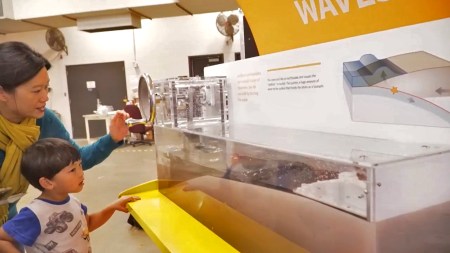
It’s no surprise that many museums choose to entertain and educate visitors with the stuff that covers 71 percent of our planet’s surface. Water can contribute greatly to a wide variety of museum exhibits and to the enjoyment of audiences, offering visitors a different way to engage and learn. From the more passive observation of an aquarium or wave tank, to the hands-on fun of touch tables with live critters or river simulations with toy boats and dams, water can be used in a range of exhibits and interactives. Whatever your desired visitor experience, water may help you deliver it.
Is your museum considering getting its feet wet with a water-based exhibit or interactive? Here are six things to consider before you start working with water in your institution.
1. Water Must Get in and Get Out
Let’s state the obvious: you’ll need to fill your water exhibit. Make this easy by placing it near a spigot, unless you prefer wrestling a great length of garden hose through your space. Know that water can be difficult to move vertically, demonstrated by a concept called “head height.” If the fill point of your structure is well overhead, place the spigot in the ceiling to avoid this.
Similarly, you’ll need to drain your water for inevitable exhibit maintenance and eventual removal. Place your exhibit’s drain below the point of water storage so that it doesn’t require a pump to empty. While dedicated fills and drains are ideal, these needs can be addressed simply too. Sometimes a nearby janitor’s closet with a spigot and basin is all it takes.
2. Water is Heavy
As any backpacker knows, water is heavy! While the wet stuff technically weighs eight pounds per gallon, it’s better to estimate ten pounds per gallon to be on the safe side. With this rule of thumb, consider that a one-hundred-gallon tank weighs one thousand pounds. All this weight requires careful deliberation when placing your water exhibit. While concrete flooring should handle the weight with ease, spaces with wood construction and wooden joists should be approached with caution.
Further, exhibits with moving water, such as wave tanks or tables with river bends, need a thicker enclosure to handle the force of the movement. And, most importantly, water-based interactives need to be perfectly level to keep the distributed force of the water from warping the exhibit and causing it to fail in spectacular (read: costly) ways.
3. Water Finds a Way
Water does not like to stay put. Surely you recall from your favorite high school course (chemistry) that liquids conform to the shape of their container. This conformism means that water, in its liquid state, will find and exploit the tiniest imperfection and make a bid for freedom, known to some as a leak. Architectural design provides another cue, where one of the primary goals of every building is to restrict any water or moisture from entering.
Careful engineering and selection of proper materials will help ensure that your water stays where you want it and keep you from having to deal with frustrating and potentially costly leaks. Understanding roofing construction and flashing details are helpful when designing and building a watertight container.
4. Water Breeds Life
Remember the axiom often falsely attributed to Benjamin Franklin, “In wine there is wisdom. In beer there is freedom. In water there is bacteria.” Algae, bacteria, and other lifeforms thrive in water, and they will make themselves at home in your exhibit if you let them. Closed-tank interactives such as wave simulators can use food-grade mineral oil or other substitutes that don’t support life. Where water is necessary and living organisms are not wanted, avoid direct sunlight and treat water with chlorine or bleach.
Of course, many water exhibits are designed to support aquatic life (fish and other such things). In that case, be prepared for the maintenance required to keep algae and other unwanted biologicals at bay. This may include proper cleaning, aeration, water treatment, or the expertise of a trained aquarist.
5. Water Affects Exhibits & Vice Versa
If you’re building a water exhibit, you’ll probably want to place some other exhibit elements nearby. Be aware that the two don’t always play nice. Moisture in the air can condense on wall surfaces and wreak havoc on printed and applied graphics. Depending on the duration of your exhibit, consider using materials, finishes, and printing techniques that are designed for exterior use and therefore better able to withstand water.
Things can also go in the other direction. Be mindful that chemicals from adhesives and other fabrication materials on nearby walls and exhibit surfaces can leach into water, making it toxic to aquatic species. To prevent this, with exhibit graphics, consider using standoff panels or lettering near your water exhibits wherever possible.
6. Water is More Expensive
Water will cost you. Compared with dry exhibits, water exhibits and interactives take more time to design and build, and are more costly in terms of materials. Exhibits with water also require significantly more research, development, and prototyping to successfully navigate the first five things in this list.
Beyond the startup costs, water exhibits also require more maintenance, troubleshooting, and cleanup than other exhibits. Nothing aids corrosion better than moisture, so it is likely that components will wear down or break. Before you start developing a water exhibit, be sure that you have the budget, the staff, and the time to properly design, build, install, and maintain it.

When done right, water-based exhibits and interactives can provide key, engaging moments that will stick with visitors—especially children!—long after they have returned home. We all have an innate connection to water, and in a museum setting it can encourage active and playful learning, instill a sense of calm thoughtfulness, and demonstrate scientific or natural history principles directly to visitors.
Whatever experience and educational outcomes you are hoping to create for visitors, consider if and how water may be able to contribute to your goals. With these factors in mind, don’t be afraid to pursue unique and compelling experiences that make a splash.
About the author:
Trevor Cunnien is an Exhibit Developer at Luci Creative, an exhibit and experience design firm with offices in Chicago and Boston. He can be reached out tcunnien@lucicreative.com
Skip over related stories to continue reading article








Great read, Trevor. My favorite line: “…water…will find and exploit the tiniest imperfection and make a bid for freedom, known to some as a leak.” Brilliant. Kudos!